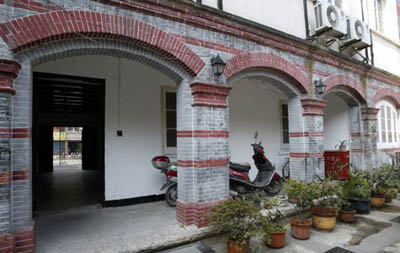Little Vienne
By Yu Wenjie (Shanghai Daily)Updated: 2007-01-09 09:27
Near the northern Bund stands "Little Vienna," the heart of the once-vibrant Jewish community in Hongkou District. Rows of buildings have been meticulously restored-just a fraction of Shanghai's enormous task of preserving historic buildings, writes Yu Wenjie.

Artisans and workers have painstakingly restored many buildings in "Little Vienna" and work is just beginning on Ohel Moishe Synagogue - the heart of Shanghai's once-vibrant Jewish community in Hongkou District near the northern Bund.
Gray walls inlaid with red bricks, arched windows and doors, red-brick pillars and pointed roofs. These mark the rows of old residential buildings around Zhoushan and Huoshan roads in the northeast Tilanqiao area.
Nearby stands Ohel Moishe Synagogue, built in 1927 by Russian immigrants. Though it is a holy place to the Jewish community, it has not been in use as a synagogue and has housed the small Shanghai Jewish Museum, which was closed on January 1 for a five-month restoration of the synagogue.
The three-year "Little Vienna" restoration project that began in 2003 has cost 10 million yuan (US$1.28 million) so far and the city hopes it will attract residents and tourists. Many Jewish people visit Shanghai to trace their roots and "Little Vienna" is on their map.
At one time Shanghai's flourishing Jewish community numbered around 30,000. The city sheltered Jews who fled persecution by Nazis in Europe and the city was one of the few places worldwide that accepted them without visas. Today the city has about 2,000 Jewish residents.
The Tilanqiao area was known as "Little Vienna" for its Jewish population and its cultural similarities to the Austrian capital. The community once had its own school, library, cafes, and even a newspaper. It once had six synagogues. Today it has two.
"This is a nice idea, preserving some buildings - a physical edifice, a physical remembrance of very special times," Rabbi Shalom D. Greenberg told Shanghai Daily. "This place was very meaningful to people who left Germany and Austria when they had no human rights whatsoever during World War II.
"They came to Shanghai and were once again treated like humans, they were welcomed warmly here and treated kindly by the people who lived here," he says.
Rabbi Greenberg calls the period a "wonderful time" and says "this haven of light during that time of darkness is truly appreciated because we can teach future generations by pointing to it. This is more meaningful than an account in a book, than words on a page."
Rabbi Greenberg says many residents in the Tilanqiao area are poor and the Jewish community is donating warm winter clothing. In remembrance of kindness to Jewish refugees, the Jewish community in Shanghai and abroad will launch a campaign in spring to assist the needy in the area, many of whom are low-income, elderly, disadvantaged and are being relocated.
Regarded as one of the city's "12 Key Preserved Historical Zones," Tilanqiao has restored the exteriors of more than 30 old buildings in the former Jewish neighborhood. Most are still occupied.
"The surroundings are more tidy and neat. The old architecture has never been so enchanting," says Tang Guowei, a long-time resident of the old neighborhood who sells children's clothing. "This is also good for business."
"Much work has been done, including dismantling illegal private shanties and balconies built by residents, reconstructing damaged architecture, and so on," says Zhu Hongshen, the Tilanqiao community official in charge of the restoration project.
The project was much more difficult than expected because every aspect needed repair and renovation - replacing the old red bricks was difficult. "The loss of old bricks with each passing day made them unique, they were crucial to the old architecture," says Zhu.
Zhu and his team scoured the city to find identical old bricks and finally discovered them at a warehouse in Qingpu, the city's southwest suburb.
"To our astonishment, the seller raised the price from two yuan (25 US cents) to six yuan per brick. We had no choice but to buy," says Zhu.
However, the more Zhu got involved in preserving the old buildings, the more he got worried. The problems he encountered and the obstacles he foresaw were far greater than a lack of bricks.
"Although Shanghai has done better than other places in protecting historical sites, it still lags far behind European countries where strict laws ensure renovation of old architecture such as castles. Even the workmanship of embellishment is specified," says Zhu.
"Compared with these, China's rules and regulations are far from enough," he adds. "How to protect and how far still remain uncertain."
The biggest problem, of course, is lack of funds. The government is mainly responsible for protecting old architecture, while in Europe and other countries non-government organizations play a fund-raising role.
Another obstacle, says Zhu, is that many people still live in historic buildings because of a housing shortage. Living conditions are deteriorating, causing tension between residents and preservationists.
"More than 60 percent of the residents should be removed. Those remaining should fulfill their obligations to their buildings, so it's very important to raise residents' awareness of the historical value of the old architecture," Zhu stresses.
He suggests charging admission to some restored public buildings, using the proceeds for maintenance, new restoration and compensating those who still live in the old buildings, encouraging more residents to protect historic buildings.
One of the men who saved "Little Vienna" from bulldozers is Professor Ruan Yishan of Tongji University, an ardent preservationist and dean of the National Cultural and Historical City Research Institute.
The northern Bund area was planned for urban development. Ruan and others determined to save the historic architecture and proposed preservation to the Shanghai Urban Planning Bureau.
They succeeded and in 2003 the city declared "12 Key Preserved Historical Zones," including Tilanqiao.
Several years ago, Shanghai was criticized for rushing into the future without thinking of the past, says Ruan, "but now things are getting a lot better. But we still have a long way to go."
|
||
|
||
|
||
| Eating out:
New haven for food lovers
Bars&Cafes: Absinthe mood Weekend&Holiday: Little Vienne Shopping: 'Forevermark' on diamonds What's on: Screaming out with Yaksa |

